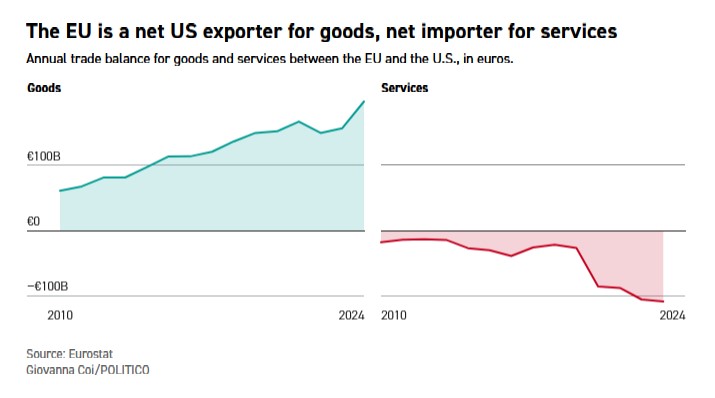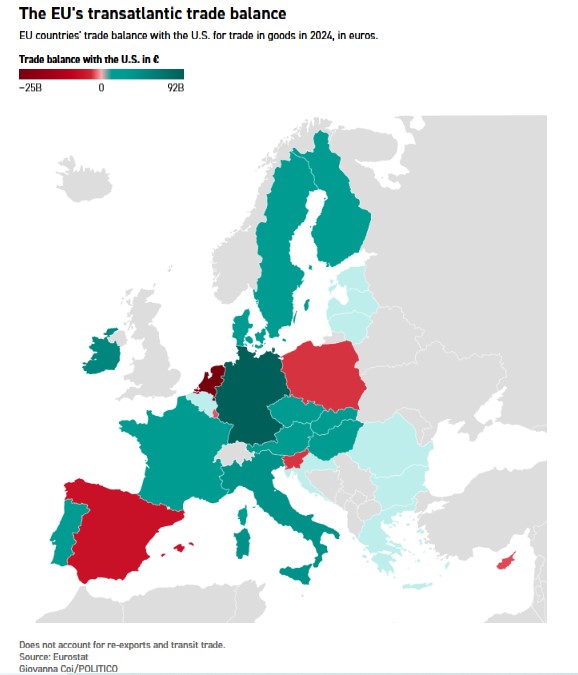President Donald Trump dumped the European Union in the worst category of America’s trade partners Wednesday, hitting the bloc with a 20 percent tariff on all imports.
Trump’s “Liberation Day” announcement puts the 27-nation bloc in the trade sin bin along with major economies like China, Japan, Taiwan and Korea. The move throws up U.S. trade barriers that haven’t been this high since the Great Depression of the 1930s.
Trump said he was declaring a national emergency to impose a 10 percent tariff on imports from all countries. Aside from that, he imposed individualized additional tariffs on approximately 60 countries which he believes are the worst trade offenders.

“For decades, our country has been looted, pillaged, raped and plundered by nations near and far, both friend and foe alike,” Trump said in the White House Rose Garden.
“Now we’re going to charge the European Union. They're very tough. Very, very tough traders. You know, you think of the European Union, very friendly. They rip us off. It's so sad to see. It's so pathetic,” Trump said.
“We are going to charge them 20 percent,” the U.S. president said.
A White House official said the 10 percent tariff would take effect early the morning of April 5 and the additional tariff on the worst offenders on April 9.
In nobody’s interest
Italian Prime Minister Giorgia Meloni was the first EU government leader to respond to Trump’s tariff blow, calling it “wrong and not in the interest of either party.”
“We will do everything we can to work on an agreement with the United States with the aim of averting a trade war that would inevitably weaken the West in favor of other global players,” Meloni, who has hitherto enjoyed friendly relations with Trump, said in a Facebook post.
The Trump administration estimates the tariffs charged by the European Union to the United States at 39 percent, and cuts this figure by half to come up with the 20 percent, in what Trump labelled “kind reciprocal” tariffs.
The Trump administration took particular offense at what it views as the EU’s nontariff barriers, such as value-added tax and its tech regulations. It factored these into its calculations — although the Europeans flatly reject its view that either discriminate against American businesses.
In fact, over 70 percent of imports to the EU are duty-free. And, on a trade-weighted basis, EU tariffs average just 2.7 percent, according to the World Trade Organization.
Trump’s tariff offensive came as a slap in the face of the European Union, which sought to bring his administration to the negotiation table in the lead-up to Wednesday’s announcement. EU trade chief Maroš Šefčovič went to Washington twice to meet with his U.S. counterparts — to no avail.

The European Commission said earlier it would respond in one strike to Trump’s reciprocal tariffs and auto tariffs, in addition to its answer to U.S. steel and aluminum duties already in force.
Commission President Ursula von der Leyen responded in the early hours of Thursday, saying that the bloc was "prepared to respond."
“There seems to be no order in the disorder. No clear path through the complexity and chaos that is being created, as all U.S. trading partners will be hit,” von der Leyen said in a televised statement.
The new “reciprocal” tariffs will not be stacked on top of the sectoral tariffs that Trump has already announced for autos, steel and aluminum, and that are expected for lumber, copper, pharmaceuticals, semiconductors and potentially critical minerals, White House officials said.
(by politico.eu, April 2, 2025)